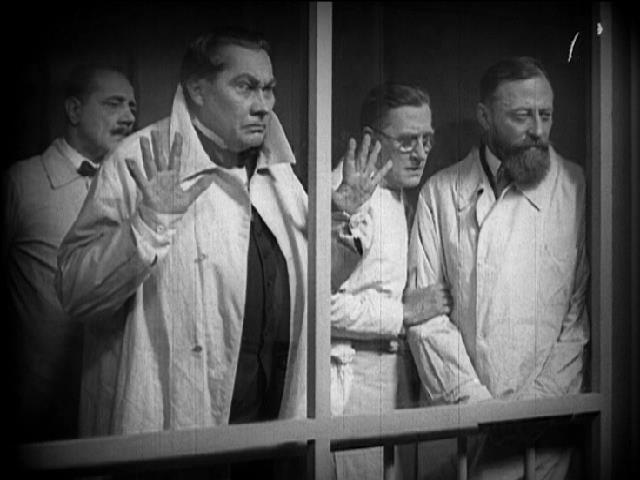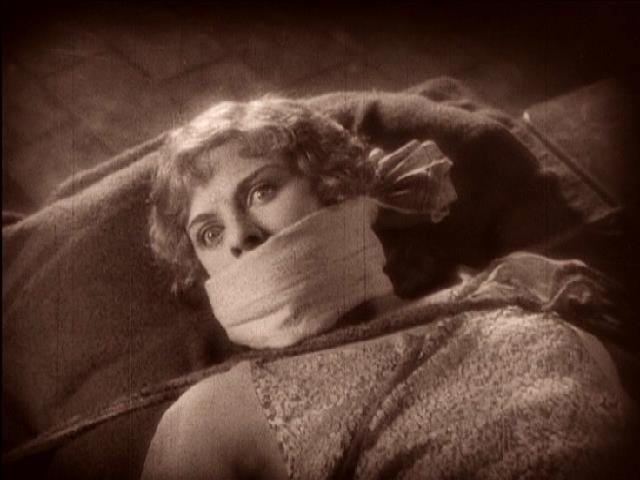Actually, calling The Magician an American film is a little open to question, since Ingram—disliking the increasing supervision of the studio in general and Louis B. Mayer in particular—set up his own studio in France in 1924, which is where The Magician was made. Bear in mind that 1924 is the year that Metro became Metro-Goldwyn-Mayer. It’s also the start of movies having a “supervisor” (essentially a producer) over the director. How much did Ingram dislike Mayer? Well, you’ll notice that the titles on The Magician read “Metro-Goldwyn presents” and call it a “Metro-Goldwyn Production.” That should provide a hint. Nonetheless, the film was made for an American studio and was distributed by them, so it does qualify as an American production.
It also looks like an American silent film in its general lack of camera movement. I think the camera—except mounted on something that is moving, as in the carousel sequence—moves twice in the entire film. This, however, has more to do with Ingram having been what was called a “pictorialist” filmmaker—a painterly style of filmmaking where composition is the primary factor, with each shot composed as if it was a painting. It’s a style that has long been out of fashion and was headed that way even in 1926, but it has its merits and Ingram was a master of it. It doesn’t make his films uncinematic. The shot breakdown is very elaborate and every composition is precise.
The film is adapted from Somerset Maugham’s 1908 novel of the same name, a work that was based on the notorious Aleister Crowley (who reviewed the book under the pseudonym “Oliver Haddo,” which not coincidentally is the name of the novel’s magician). Crowley claimed to be a powerful magician and even referred to himself as “The Beast” from the Book of Revelation in the Bible. (How much this had to do with having been raised in the faith of the Exclusive Brethren—an even more repressive and strict sect of the pretty darn repressive and strict Plymouth Brethren—is open to conjecture.) Whether or not Crowley truly was a magician is debatable. He was certainly a mystic, a lecher, a drug addict, a pornographer, a mountaineer, an accomplished writer and chess player—and a tireless self-promoter, who reveled in his reputation for wickedness. Apart from the clearly fantastic story, the film of The Magician is probably the closest the movies ever came to capturing Crowley on the screen, though The Black Cat (1934) and Night of the Demon (1957) have elements of him.
Ingram’s version simplifies much of Maugham’s novel, but it also affords it a dynamic third act — something the book lacks, The story follows Haddo (Wegener) as he mystically seduces Margaret Dauncey (Ingram’s wife Alice Terry, who is frankly a bit mature for a maiden) for his homunculus experiment. This seduction involves transporting her to hell—or so it seems in the film’s famous and very pre-code hell sequence—where she is taunted by Haddo (his hair amusingly twisted into horns) and seemingly raped by a largely naked satyr (the dancer Stowitts). It’s a great scene, but it doesn’t make a lot of sense in context, since she’d no longer be a maiden had it happened, but presumably it’s merely a fantasy.
The Magician goes full-tilt into horror-movie mode—it’s tempting to say horror-movie-template mode—when it gets to Haddo’s attempt to carry out his plan. All the trappings of the mad-scientist horror film are in evidence, with the notable absence of the electrical devices, which have no place in a story about sorcery, though there’s no shortage of atmospheric lightning. Otherwise, we might as well be in the tower of Dr. Frankenstein in Frankenstein (1931) or Bride of Frankenstein (1935). In fact, the idea that James Whale and Universal production designer Charles D. Hall hadn’t seen The Magician is clearly preposterous. So if you want to see where it all began, The Magician is the place to do it.
The Thursday Horror Picture Show will screen The Magician Thursday, Aug. 13 at 8 p.m. in Theater Six at The Carolina Asheville and will be hosted by Xpress movie critics Ken Hanke and Justin Souther.









Before you comment
The comments section is here to provide a platform for civil dialogue on the issues we face together as a local community. Xpress is committed to offering this platform for all voices, but when the tone of the discussion gets nasty or strays off topic, we believe many people choose not to participate. Xpress editors are determined to moderate comments to ensure a constructive interchange is maintained. All comments judged not to be in keeping with the spirit of civil discourse will be removed and repeat violators will be banned. See here for our terms of service. Thank you for being part of this effort to promote respectful discussion.